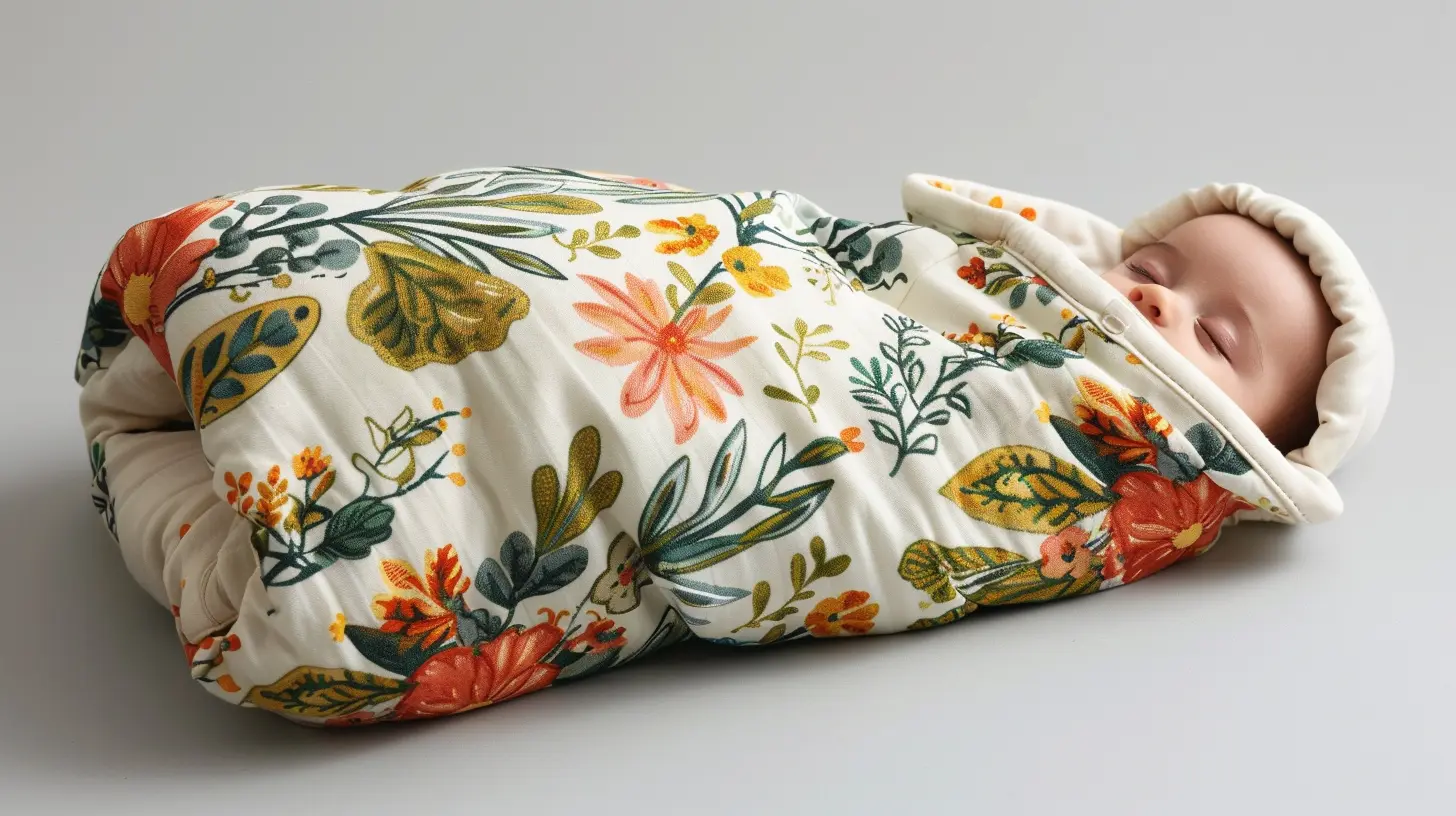The Benefits of Swaddling for Newborns
4 July 2025
Welcoming a newborn into your life is an incredible experience, but let’s be honest—it comes with sleepless nights and endless questions. One of the age-old techniques that can make those early days a little easier? Swaddling.
Swaddling is more than just wrapping your baby up like a cozy little burrito. It has been practiced for centuries and is praised for its calming effects on newborns. But what exactly makes swaddling so beneficial? Let’s dive into it!

What Is Swaddling?
Swaddling is the practice of snugly wrapping a baby in a soft, breathable blanket to help them feel secure, just like they did in the womb. It's not just an old wives’ tale—there’s science behind it. When done correctly, swaddling can improve sleep, reduce crying, and even support healthy development.But before you start wrapping your baby up, it’s important to understand both the benefits and the best techniques to ensure safety and comfort. 
1. Helps Babies Sleep Better
Let’s talk about one of the biggest struggles new parents face—sleep deprivation. Newborns tend to startle themselves awake due to something called the Moro reflex, which is an involuntary reflex causing sudden arm and leg movements. This reflex is completely normal but can make it difficult for babies to stay asleep.Swaddling helps by keeping their arms snugly wrapped, preventing sudden movements that could wake them up. A well-swaddled baby is often a better-rested baby, and when your little one sleeps better, so do you! 
2. Soothes Fussiness and Reduces Crying
Newborns cry—a lot. And sometimes, it feels like nothing will calm them down. But swaddling has been shown to mimic the cozy, snug feeling of the womb, which can instantly have a soothing effect on your baby.Think of it like a warm hug—swaddling provides gentle pressure that makes babies feel secure. Studies have even shown that swaddled babies cry less compared to those who aren’t swaddled. Pair it with gentle rocking or white noise, and you might find yourself with a much calmer baby. 
3. Supports Proper Sleep Positioning
Safe sleep is every parent’s priority. The American Academy of Pediatrics (AAP) recommends that babies sleep on their backs to reduce the risk of Sudden Infant Death Syndrome (SIDS).Swaddling helps keep babies on their backs by preventing excessive rolling. When a baby’s arms are tightly wrapped, they’re less likely to accidentally flip onto their tummy, which is a known risk factor for SIDS.
However, once your baby starts showing signs of rolling over (usually around 2-3 months), it’s time to transition out of the swaddle to keep them safe.
4. Keeps Babies Warm and Comfortable
Newborns have a tough time regulating their body temperature. Unlike adults, they can’t just pull up a blanket if they feel cold.A properly swaddled baby stays warm and comfortable throughout the night without the need for loose blankets, which can be a suffocation hazard. Swaddle blankets made of breathable materials like cotton or muslin help keep your baby at just the right temperature.
That being said, it’s important not to overdo it—overheating can be dangerous. Always check your baby’s temperature by feeling the back of their neck. If they’re sweaty or too warm, it’s time to loosen the wrap or opt for a lighter swaddle material.
5. Reduces the Risk of Sudden Movements
Babies have unpredictable movements while they sleep. Sometimes, they wake themselves up with sudden jerks or flailing arms. Other times, they scratch their faces with their tiny, sharp nails without even realizing it.Swaddling gently restricts movement, reducing the risk of these sudden, accidental disruptions. It helps your baby stay calm and rest peacefully, which is a win-win for both parents and newborns.
6. Encourages Self-Soothing
We all want our babies to develop self-soothing skills so they can sleep soundly without needing constant rocking or pacifiers.Swaddling provides a sense of security, helping babies learn to settle themselves. When wrapped snugly, babies often feel comforted without needing extra help from parents, making bedtime routines much easier in the long run.
7. Eases the Transition from Womb to World
Can you imagine spending nine months in a warm, snug, cozy environment, only to suddenly be introduced to bright lights, loud noises, and unfamiliar sensations? It’s no wonder newborns feel overwhelmed.Swaddling helps re-create that safe, womb-like feeling, making the transition smoother. It’s like giving them a little piece of comfort that reminds them of home—before they were even born!
How to Swaddle Correctly (Step-by-Step)
While swaddling has amazing benefits, doing it improperly can lead to issues like hip dysplasia or overheating. Here’s how to swaddle safely:Step 1: Lay the Blanket Flat
Spread out a lightweight swaddle blanket on a flat surface and fold one corner down about 6 inches.Step 2: Place the Baby on the Blanket
Lay your baby on their back with their shoulders aligned with the top fold of the blanket.Step 3: Wrap One Side
Take one side of the blanket and gently pull it across your baby’s body, tucking it under their opposite side. Their arms can be inside or outside depending on their comfort.Step 4: Fold Up the Bottom
Bring the bottom of the blanket up over your baby’s feet, leaving room for movement in their hips and legs.Step 5: Wrap the Other Side
Take the remaining side and wrap it snuggly across your baby’s body, tucking it under their back. The swaddle should be snug but not too tight—your baby’s hips should still be able to move freely.Important Swaddling Safety Tips
Swaddling is beneficial, but safety always comes first. Keep these tips in mind:✅ Always place your baby on their back to sleep
✅ Make sure the swaddle is snug but not too tight
✅ Leave enough room for hip and leg movement
✅ Stop swaddling once your baby shows signs of rolling
✅ Use breathable fabrics to prevent overheating
If your baby doesn’t seem to like swaddling, don’t force it! Some babies prefer to sleep with one or both arms out, so experiment to see what works best.
When to Stop Swaddling
As much as swaddling helps in the early months, it’s not a long-term sleep solution. Once your baby starts rolling over (usually between 2-3 months old), it’s time to stop swaddling to prevent safety risks.To make the transition easier, you can try:
- Swaddling with one arm out first
- Using a sleep sack as a middle-step
- Offering other soothing techniques like white noise or rocking
Each baby is different, so follow their cues and adjust accordingly!
Final Thoughts
Swaddling is a game-changer for many parents. It helps newborns sleep better, cry less, and feel safe in their new world. While it’s not a one-size-fits-all solution, most babies find comfort in the snug, womb-like embrace of a well-wrapped swaddle.If your little one seems unsettled or struggles with sleep, swaddling just might be the magic trick you need. Just remember—safe swaddling always comes first!
Sweet dreams, little one.
all images in this post were generated using AI tools
Category:
Baby CareAuthor:

Tara Henson
Discussion
rate this article
1 comments
Nixie McConnell
Swaddling can provide newborns a sense of security and comfort, helping them sleep better. It also may reduce the startle reflex, promoting a more peaceful environment for both baby and parents.
July 10, 2025 at 3:03 AM

Tara Henson
Thank you for your insightful comment! Swaddling indeed offers newborns comfort and security, which can enhance sleep quality and reduce disturbances.


